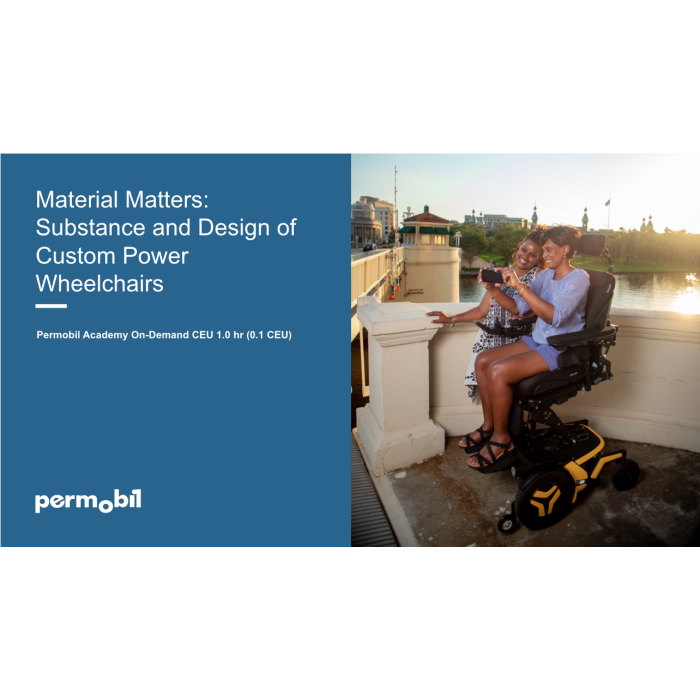Material Matters: Substance and Design of Custom Power Wheelchairs
This 60-minute lecture will address how materials are designed, used and combined in CRT to improve the lives of clients and provide a comprehensive look at ...
Education Level = Intermediate, Credit = 0.1 CEU/ 1 CCU
AOTA Category: OT Service Delivery CEU(s)/Contact Hour(s): 0.1 AOTA CEUs/1 Contact Hour
State PT Approval: This course has been approved by the Maryland State Board of Physical Therapy Examiners for .1 CEUs. Approval expires 10/22/24. Please be sure to complete this course before this date.
Instructional Method: Recorded on-line asynchronous lecture with supporting video demonstration
The materials used in complex rehab technology (CRT) are sophisticated and varied. Clinicians and ATPs recommend CRT for their clients every day, and the composition of this equipment has a direct impact on the clients’ health, functional performance, physical experience, and overall quality of life. Clinical decision making should include a more in depth understanding of the materials that make up the equipment selected. Yet, many clinicians and ATPs have had a lack of extensive training and experience with these materials due to insufficient emphasis in current trainings and courses, productivity demands of the rehab clinic, and an ever-changing industry involving improving technologies and materials.
This 60-minute live lecture will address how materials are designed, used and combined in CRT to improve the lives of clients and provide a comprehensive look at materials that are typically incorporated into power wheelchairs. Current evidence regarding ALS clinical outcomes and the implications of seating and mobility on clients with ALS will be reviewed. Materials such as plastics, rubbers, gels, steel, aluminum, and copper will be reviewed, with an emphasis on the complexities and variations that exist within these deceptively general material descriptions. By the end of the course, clinicians will have an improved ability to recognize different materials associated with individually configured power wheelchair design and be able to discuss significant advantages and disadvantages of each material.
| Course Outline |
|
||||||||||||
|---|---|---|---|---|---|---|---|---|---|---|---|---|---|
| Who Enrolls | This program is designed for Occupational Therapists, Occupational Therapy Assistants, Physical Therapists, Physical Therapist Assistants, Assistive Technology Professionals, and Medical Suppliers/Providers | ||||||||||||
| Instructor Information | Jennith Bernstein, PT, DPT, ATP: Jennith has been a practicing PT for 13 years and spent the last 10 years at a model SCI center (Shepherd Center) in Atlanta, Georgia. Jennith completed her Masters in Physical Therapy at North Georgia College & State University and return to complete her transitional DPT at University of Texas Medical Branch in 2014. While at Shepherd Center, Jennith, initiated a “Seating Champion” program to improve the inpatient and day program clinicians understanding of complex seating, pressure management and skin protection as well as research reviews, advanced programming and adjustments. She was also part of a center wide multidisciplinary focus group for reduction of hospital acquired skin breakdown. Jennith has served as a volunteer teacher at the Universidad Mariano Galvez in Guatemala, instructing spinal cord injury curriculum as well as seating and mobility. Jennith has presented at national and international conferences such as RESNA, ISS, Expo Ortopedica, and the APTA NEXT conference. Jennith joined Permobil as a Clinical Education Manager in 2016. |


